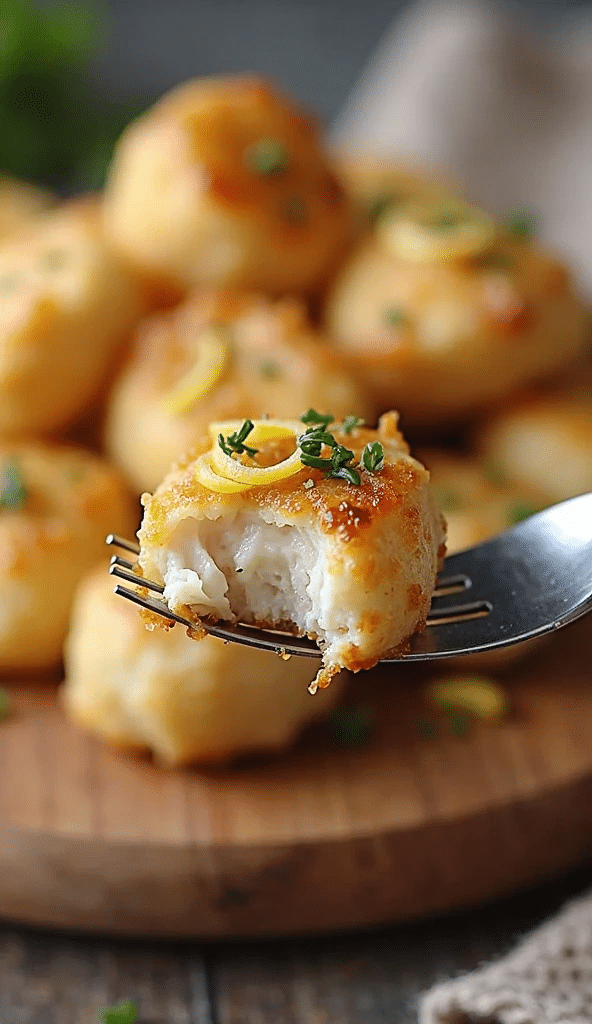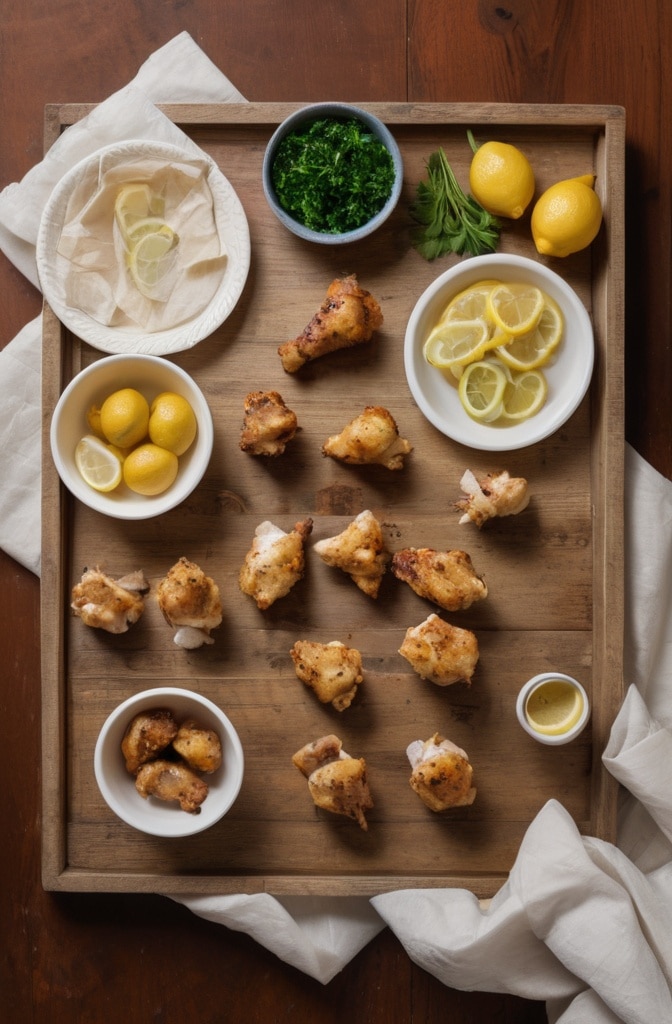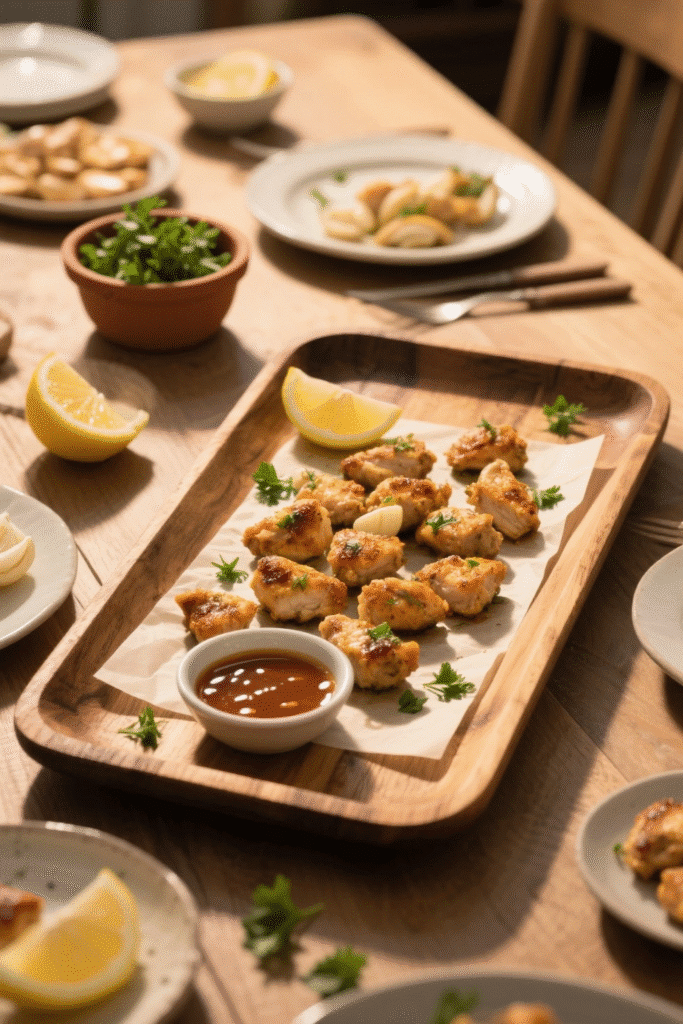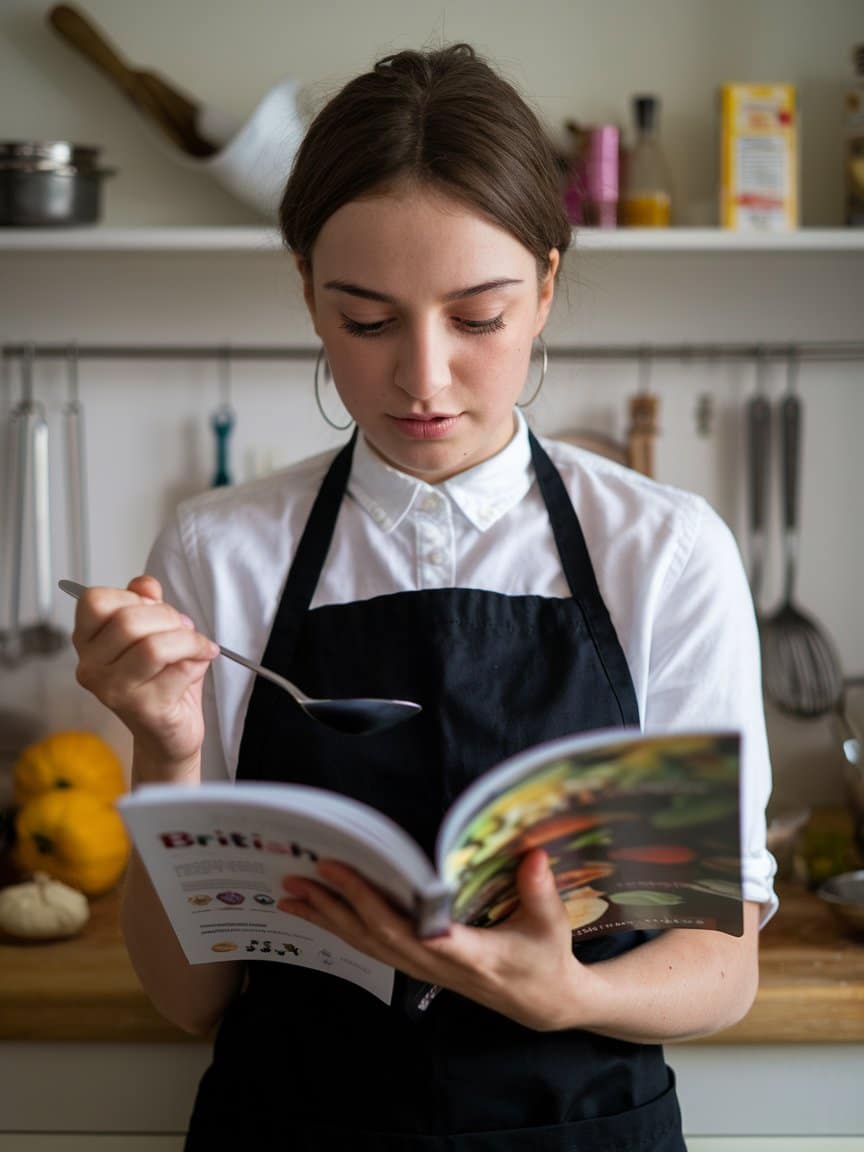I still remember the first time I tasted properly executed lemon garlic chicken bites at a small family-owned restaurant in southern Italy. The burst of acidic brightness from the lemon cutting through the rich umami depth of garlic-infused chicken literally stopped me mid-conversation. How could somethin so seemingly simple deliver such a complex flavor profile? Since that moment, I’ve spent countless hours in professional kitchens perfecting this deceivingly straightforward dish.
Lemon garlic chicken bites represent culinary harmony at its finest—tender cubes of juicy chicken married with the tangy punch of fresh lemon and the earthy warmth of garlic. What sets this dish apart isn’t just its incredible flavor balance but its remarkable versatility. These bite-sized morsels can serve as an elegant appetizer at upscale gatherings, a protein-packed main course alongside fresh vegetables, or even as a crowd-pleasing addition to pasta and grain bowls.
Ingredients & Substitutions
Primary Ingredients
- 1½ pounds boneless, skinless chicken thighs (preferred) or breasts, cut into 1-inch cubes
- 6 cloves garlic, minced (about 2 tablespoons)
- Zest of 2 lemons (preferably organic)
- ¼ cup freshly-squeezed lemon juice
- 3 tablespoons extra virgin olive oil, divided
- 1 tablespoon fresh thyme leaves (or 1 teaspoon dried)
- 1 tablespoon fresh rosemary, finely chopped
- 1 teaspoon sea salt
- ½ teaspoon freshly ground black pepper
- ¼ teaspoon red pepper flakes (optional)
- 2 tablespoons unsalted butter
- Fresh parsley for garnish, roughly chopped
The foundation of exceptional lemon garlic chicken bites begins with thoughtful ingredient selection. Chicken thighs, while slightly higher in fat content, provide unmistakably superior flavor and moisture retention compared to breast meat. They’re also more forgiving during cooking—maintaining juiciness even when slightly overcooked. However, if your preferring a leaner option, breast meat works beautifuly with a slight adjustment to cooking time.
For the garlic component, resist the temptation to use pre-minced jarred options. Fresh garlic cloves contain volatile compounds that begin degrading immediately after crushing, so mincing just before cooking delivers significantly more vibrant flavor. The diffrence is genuinely remarkable to anyone with a trained palate.
When selecting lemons, reach for unwaxed organic varieties whenever possible. You’ll be using both juice and zest, and conventional lemons often carry pesticide residues and wax coatings on their exteriors. If organic isn’t available, thoroughly scrub conventional lemons under warm water before zesting.
Worthy Substitutions
For dietary restrictions or ingredient availability, consider these professional-grade substitutions:
- Protein alternatives: Firm tofu, pressed and cubed, works surprisingly well for vegetarian options, though you’ll need to adjust cooking time downward to about 2-3 minutes per side. For pescatarians, firm white fish like halibut or monkfish maintains textural integrity.
- Citrus variations: Meyer lemons provide a gentler, slightly sweeter profile if regular lemons prove too acidic for your taste. In extraordinary circumstances where fresh lemons aren’t available, a combination of lime juice and orange zest creates a reasonable facsimile, though the flavor complexity will differ.
- Fat considerations: For those avoiding dairy, omit the butter finish and increase olive oil by one tablespoon. Alternatively, cultured plant-based butters containing cultures and sea salt deliver similar richness without the lactose.
- Herb adaptations: While thyme and rosemary offer classical Mediterranean complements, oregano provides a more robust alternative that stands up beautifully to the lemon-garlic combination. Fresh herbs will always provide superior flavor, but quality dried herbs are acceptable when stored properly and used within six months of purchase.
Step-by-Step Instructions
Preparation Phase
- Begin by properly drying your chicken pieces with paper towels. This crucial step removes excess moisture that would otherwise inhibit proper browning and caramelization. I can’t emphasize this enough—properly dried protein surfaces are non-negotiable for developing proper color and texture.
- In a large mixing bowl, combine chicken cubes with 2 tablespoons olive oil, minced garlic, lemon zest, half the lemon juice, thyme, rosemary, salt, pepper, and red pepper flakes if using. Toss until chicken is thoroughly coated, then allow to marinate for at least 15 minutes at room temperature or up to 4 hours refrigerated. Room temperature protein cooks more evenly than cold, so if refrigerating, remove the chicken 20 minutes before cooking.
- Heat a large heavy-bottomed skillet (preferably cast iron or carbon steel) over medium-high heat until quite hot but not smoking. Add the remaining tablespoon of olive oil and swirl to coat the surface. A properly preheated pan is essential—too cool and the chicken will steam rather than sear; too hot and you’ll burn the garlic before the chicken cooks through.
Cooking Process
- Working in batches to avoid overcrowding (which causes steaming instead of searing), add chicken pieces to the pan, ensuring each piece has space around it. Cook undisturbed for approximately 3-4 minutes until a golden-brown crust forms on the first side. Over-manipulating the chicken during this crucial stage prevents proper caramelization.
- Using tongs, flip each piece individually and cook for an additional 2-3 minutes until the internal temperature reaches 165°F (74°C) for breasts or 170-175°F (77-79°C) for thighs. A instant-read thermometer is the only reliable method for determining doneness—visual cues can be decieving, especially with marinated meats.
- Once the final batch is cooked, return all chicken to the pan, reduce heat to low, and add butter along with the remaining lemon juice. The residual pan heat will emulsify the butter into the lemon juice, creating a silky, flavor-intensified glaze that coats each chicken piece. This final glazing step, often overlooked in home cooking, distinguishes restaurant-quality preparations.
- Remove from heat immediately once butter has melted and sauce has slightly thickened, approximately 30-45 seconds. Excessive cooking at this stage will break your emulsion and potentially toughen the chicken.
- Transfer to a serving platter, drizzling any remaining pan sauce over the top, and garnish generously with fresh parsley. Serve immediately for optimal texture and flavor.
Common Mistakes and Solutions
The most frequent error when preparing lemon garlic chicken bites is excessive marinade time. The acid in lemon juice begins breaking down protein structures immediately, and extended exposure (beyond 4 hours) results in mealy, texturally compromised chicken. If prep timing requires advance work, combine all marinade ingredients except lemon juice, which should be added no more than 4 hours before cooking.
Another pitfall is inadequate pan temperature. Your skillet must be properly preheated to achieve the Maillard reaction responsible for developing complex flavor compounds and appealing color. Test your pan by adding a single drop of water—it should dance across the surface rather than immediately evaporating or sitting in place.
Finally, avoid the temptation to constantly move the chicken pieces during cooking. Professional kitchens achieve superior caramelization by practicing patience and minimal intervention. Place the chicken, then leave it undisturbed until properly seared before flipping.
Cooking Techniques & Science
The magic of lemon garlic chicken bites lies in understanding the interplay between acid, fat, heat, and protein. Lemon juice’s citric acid partially denatures proteins in the chicken, creating micro-pockets that later fill with rendered fat and flavorful compounds during cooking. This process, similar to a quick “pre-cure,” enhances both flavor penetration and moisture retention.

The aromatic compounds in garlic (primarily allicin) are fat-soluble rather than water-soluble, which explains why olive oil in the marinade enhances garlic flavor distribution throughout the dish. When these compounds meet high heat during cooking, they undergo chemical transformations that mellow harsh notes while developing complex sweetness—a process that’s impossible to achieve with pre-cooked garlic.
The final butter-mounting technique (adding cold butter to create an emulsified sauce) employs the principles of colloidal suspension. The milk solids in butter act as natural emulsifiers, creating microscopic bridges between water molecules (from lemon juice) and fat molecules, resulting in a sauce that clings beautifully to each chicken piece rather than separating into greasy pools.
For optimal textural results, cast iron or carbon steel pans significantly outperform standard aluminum or non-stick options. These materials store and distribute heat more effectively, maintaining consistent temperature even when cold chicken is added. They also develop micro-textures that enhance browning through increased surface contact area—a phenomenon documented in thermal imaging studies of professional cookware.
Serving & Pairing Suggestions
Lemon garlic chicken bites shine brightest when contrasted with complementary flavors and textures. For an elegant appetizer presentation, skewer individual pieces with cocktail picks and serve alongside a cooling tzatziki or whipped feta dip. The creamy dairy components balance the bright acidity while enhancing the dish’s Mediterranean roots.

As a main course, serve atop a bed of pearl couscous or orzo pasta tossed with wilted spinach and halved cherry tomatoes. The pasta captures excess sauce while providing textural contrast to the tender chicken. A side of charred lemon halves offers both visual appeal and the option for guests to adjust acidity to personal preference.
For wine pairings, reach for bottles with sufficient acidity to match the lemon component while complementing the rich garlic notes. A crisp Vermentino from Sardinia works beautifully, as does a mineral-driven Assyrtiko from Santorini. For red wine enthusiasts, choose lighter-bodied options with minimal oak influence—perhaps a Gamay or Loire Valley Cabernet Franc served slightly chilled.
Beer aficionados should consider Belgian witbiers or German hefeweizens, whose citrus and spice notes echo elements in the dish without overwhelming the palate. The carbonation provides palate-cleansing refreshment between bites.
For family-style service, arrange chicken bites in a shallow earthenware dish over a smear of Greek yogurt seasoned with additional lemon zest and minced herbs. The temperature contrast between hot chicken and cool yogurt creates an additional dimension of sensory experience that elevates the overall impression.
Creative Variations
While the classic preparation delivers exceptional results, professional kitchens often develop signature variations to distinguish their offerings:

Mediterranean Version: Add 1 tablespoon of capers, ¼ cup pitted Kalamata olives (roughly chopped), and 1 teaspoon dried oregano to the base recipe. Finish with crumbled feta cheese after cooking for a robust flavor profile reminiscent of Greek island cuisine.
North African Twist: Incorporate 1 teaspoon each of ground cumin and coriander, plus ½ teaspoon ground cinnamon into the marinade. Garnish with toasted pine nuts and chopped preserved lemon for an elegant Moroccan-inspired adaptation.
Asian-Influenced Version: Substitute lime for lemon, add 1 tablespoon grated ginger and 2 teaspoons fish sauce to the marinade. Finish with chopped cilantro, mint, and a drizzle of chili oil for a Southeast Asian flavor direction that pairs brilliantly with jasmine rice.
Herbaceous Garden Variation: Double the herb quantities in the base recipe and add 1 tablespoon each of chopped tarragon and basil. After cooking, finish with a gremolata of finely chopped parsley, additional lemon zest, and one minced garlic clove for a fresh, garden-inspired profile.
Each variation maintains the core technique while introducing flavor elements that transport the dish across culinary traditions. The fundamental cooking method remains consistent, with only marinade components and finishing elements changing to create distinctly different experiences.
Conclusion
Lemon garlic chicken bites represent the beautiful intersection of accessibility and culinary excellence. The dish requires no specialized equipment or exotic ingredients yet offers endless opportunities for personalization and refinement. What distinguishes exceptional versions from merely adequate ones lies not in complex techniques but rather in attention to detail—properly drying the chicken before cooking, maintaining appropriate heat levels, exercising patience during searing, and finishing with the butter-mounting technique.
The most common pitfall remains overthinking this fundamentally straightforward preparation. Trust in the quality of your ingredients and the proven techniques outlined above. Allow the natural affinity between chicken, lemon, and garlic to shine through without unnecessary complication.
I’ve prepared this dish hundreds of times across various professional settings, from casual kitchen classrooms to fine dining establishments, and its appeal remains universal. There’s something profoundly satisfying about creating depth and complexity from such a concise ingredient list—a reminder that culinary mastery often manifests not through elaboration but through understanding and respecting fundamental flavor relationships.
Whether served as a crowd-pleasing appetizer or a protein-focused main course, these bright, garlicky morsels deliver satisfaction that far exceeds their modest ingredient cost and preparation effort. They represent cooking at its most honest and rewarding—simple enough for Tuesday night dinner yet sophisticated enough for special occasions.
Frequently Asked Questions?
Can I make lemon garlic chicken bites ahead of time?
While best served immediately after cooking, you can prepare them up to 2 hours ahead and hold at room temperature. For longer storage, refrigerate after cooling, then gently reheat in a 300°F oven just until warmed through (approximately 5-7 minutes). Avoid microwave reheating, which creates undesirable textural changes and intensifies the garlic’s pungency.
Why does my chicken sometimes turn tough when cooking with lemon?
Excessive marination time in acidic ingredients like lemon juice causes proteins to denature too aggressively, resulting in a mealy texture. Limit acid exposure to 4 hours maximum, and consider adding the lemon juice component just before cooking for longer preparations. Additionally, overcooking significantly contributes to toughness—invest in an instant-read thermometer for precision.
Can I use bottled lemon juice instead of fresh?
While technically possible, bottled lemon juice lacks the volatile aromatic compounds found in fresh lemons, particularly the oils contained in the zest. These compounds provide crucial flavor complexity and brightness. Commercial processing and preservation methods significantly alter the juice’s flavor profile, resulting in a flat, one-dimensional acidity rather than the vibrant, nuanced character of freshly squeezed juice.
How do I prevent the garlic from burning during cooking?
The marinade approach incorporates garlic throughout the meat rather than leaving it exposed directly to pan heat. However, if you notice excessive browning during cooking, slightly reduce heat and occasionally deglaze with 1-2 tablespoons of water or chicken stock. Another professional technique involves removing larger pieces of minced garlic from the exterior of the chicken before placing in the pan, then adding them back during the final butter-mounting stage.
What’s the best way to serve these for a large gathering?
For events serving 20+ guests, consider the chafing dish approach: slightly undercook the chicken (to 160°F internal temperature), then transfer to a preheated chafing dish with the butter-lemon sauce. The gentle residual heat will complete cooking without overcooking, and the covered environment preserves moisture. Refresh with additional chopped herbs and lemon zest every 30 minutes to maintain visual appeal and aromatic presentation.

Veronica is a passionate food enthusiast with over three years of experience in exploring and writing about diverse cuisines. Her expertise lies in reviewing restaurants, sharing creative recipes, and discovering the latest food trends. As the voice behind FoodieRecap.com, Anju brings fresh perspectives and culinary insights to her audience.
